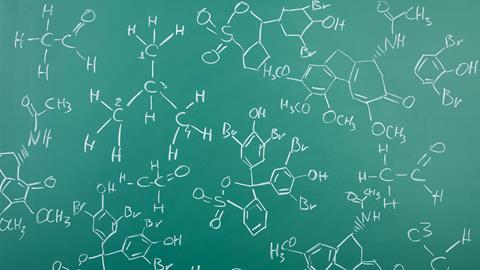Mastering organic reaction mechanisms
Although problem solving is widely acknowledged as a key skill for scientists, the deliberate development of the skill remains a challenge. After an exam, it’s common to hear ‘That wasn’t fair – we’ve never done that before’, when the question simply required the application of knowledge that had been encountered before to an unseen example.
The application of knowledge and skills to a new problem is not such a simple task in practice, as shown in a new study by Melissa Weinrich and Hannah Sevian, which investigated students’ abstraction while solving mechanistic problems in organic chemistry. The lessons learned provide valuable insight for those who teach organic chemistry at all levels.
A key challenge for students when approaching mechanisms is understanding the symbolic representation of abstract concepts and processes, with many students adopting a join-the-dots approach to drawing a mechanism with curly arrows. Success in this is connected to the ability to derive and apply the implicit features of representations (eg the presence and influence of electronegative atoms, lone pairs, etc) rather than relying on the interpretation of explicit features such as the atoms shown in a formula and the lines connecting them.
Three approaches
Previous work has shown students adopt three reasoning approaches when solving problems. Students using ‘rule-based’ reasoning are often unsuccessful as they attempt to solve complex problems with reference to a single rule (eg nucleophiles attack electrophiles). Greater success is achieved with ‘case-based’ reasoning, where they might apply a specific reaction, and the sequence of processes it comprises, to solve a related problem. ‘Model-based’ reasoning (eg the application of the SN 2 mechanistic model) also fosters success, allowing students to break problems down into chunks.
In this study, the researchers interviewed students after exams, using Livescribe pens to capture written work and the accompanying verbal narrative. They used representation mapping, comparing students’ ‘new instance’ representations – ie how they view the problem at hand – with their ‘stored knowledge’ representations, which relate to the resources applied by students to solve the problem. In doing this, the researchers derived the level of abstractness in approach. Phrases such as ‘I need to form a line here’ and ‘I need to get rid of this OH’ were deemed to characterise low levels of abstractness, in contrast to phrases such as ‘Oxygen is electronegative … the carbon attached to the oxygen could be an electrophile’.
While I’ve captured the essence of the study here, there is much more covered in the article itself. The data, including quotes and handwritten mechanisms, provides fascinating insight into students’ thought processes – something a simple handwritten mechanism viewed ‘after the event’ fails to convey. One of the key conclusions of the authors is that higher levels of abstraction are characteristic of students who are better able to generate plausible mechanisms and demonstrate understanding of the underlying principles, which infers important implications for educators.
Teaching tips
The constraints of exam-based assessment mean that all we are assessing is the final product – a student’s handwritten reaction mechanism – and not the thought processes that led to it. So it’s unsurprising that students can become fixated on getting the diagram right, thinking ‘this arrow needs to go here and I need to draw that line there’, rather than using abstract thought to derive their solution. The researchers suggest this can be addressed by tailoring classroom assessments to encourage the development of flexibility in abstraction and appropriate reasoning skills.
- When introducing a mechanism, focus first on the implicit features of representations (typically displayed formulas) by asking students to identify electronegative atoms, labelling dipoles and adding lone pairs.
- Before teaching what actually happens, ask them to suggest, with explanation, what could happen in a reaction in view of these implicit features.
- Encourage students to describe the functions of entities and their role in a mechanism (classed as ‘high abstractness’) rather than simply describing their structures.
- Discourage terms like ‘this arrow goes here’, instead referring to ‘this pair of electrons is donated …’.
- Having taught a mechanism with one example, provide students with related problems to solve by applying their learning, providing opportunities to develop more effective abstraction and reasoning skills.
- Ask students to identify and describe the differences between reacting entities, different examples of the same mechanism, and different types of mechanism.
- Use assessments that encourage students to verbalise their thought processes. For example, they could give a presentation or make an animations or video. Peer review with teacher input can help to ensure students are correctly describing the features of reacting entities in terms that allow them to explain (and predict) reactivity.
In my experience, some students prefer to rely on memorising mechanisms because they can, and it is hard work to get their heads around the underlying principles. Pair them up with students who are able to apply their knowledge to unseen examples so they learn the value of moving beyond rote-learning.
Resources
- Student self-assessment resources for developing the skills required to successfully identify and generate organic mechanisms
- Mechanism Inspector: an interactive resource to help students learn and test themselves on organic reaction mechanisms and their underlying chemistry
Resources
- Student self-assessment resources for developing the skills required to successfully identify and generate organic mechanisms: bit.ly/2nNmp4x
- Mechanism Inspector: an interactive resource to help students learn and test themselves on organic reaction mechanisms and their underlying chemistry:rsc.li/MechInspect
References
M L Weinrich and H Sevian, Chem. Educ. Res. Pract., 2017, 18, 169 (DOI 10.1039/C6RP00120C)










No comments yet